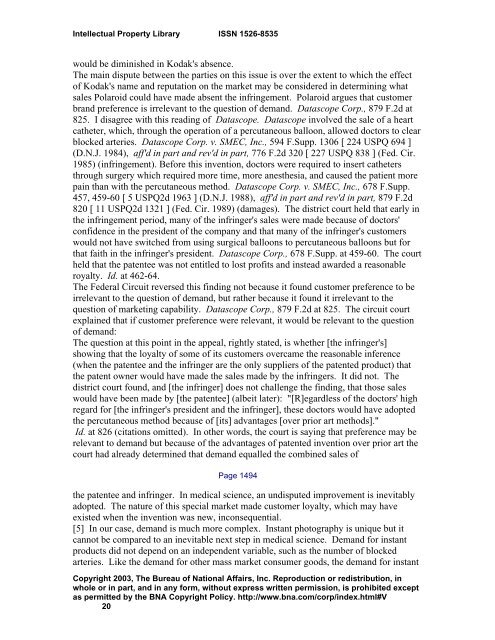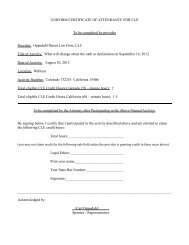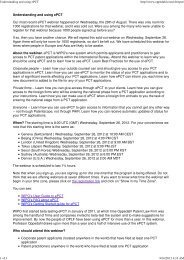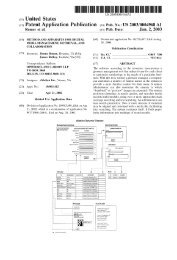Polaroid Corp. v. Eastman Kodak Co. - Oppedahl Patent Law Firm LLC
Polaroid Corp. v. Eastman Kodak Co. - Oppedahl Patent Law Firm LLC
Polaroid Corp. v. Eastman Kodak Co. - Oppedahl Patent Law Firm LLC
Create successful ePaper yourself
Turn your PDF publications into a flip-book with our unique Google optimized e-Paper software.
Intellectual Property Library ISSN 1526-8535<br />
would be diminished in <strong>Kodak</strong>'s absence.<br />
The main dispute between the parties on this issue is over the extent to which the effect<br />
of <strong>Kodak</strong>'s name and reputation on the market may be considered in determining what<br />
sales <strong>Polaroid</strong> could have made absent the infringement. <strong>Polaroid</strong> argues that customer<br />
brand preference is irrelevant to the question of demand. Datascope <strong><strong>Co</strong>rp</strong>., 879 F.2d at<br />
825. I disagree with this reading of Datascope. Datascope involved the sale of a heart<br />
catheter, which, through the operation of a percutaneous balloon, allowed doctors to clear<br />
blocked arteries. Datascope <strong><strong>Co</strong>rp</strong>. v. SMEC, Inc., 594 F.Supp. 1306 [ 224 USPQ 694 ]<br />
(D.N.J. 1984), aff'd in part and rev'd in part, 776 F.2d 320 [ 227 USPQ 838 ] (Fed. Cir.<br />
1985) (infringement). Before this invention, doctors were required to insert catheters<br />
through surgery which required more time, more anesthesia, and caused the patient more<br />
pain than with the percutaneous method. Datascope <strong><strong>Co</strong>rp</strong>. v. SMEC, Inc., 678 F.Supp.<br />
457, 459-60 [ 5 USPQ2d 1963 ] (D.N.J. 1988), aff'd in part and rev'd in part, 879 F.2d<br />
820 [ 11 USPQ2d 1321 ] (Fed. Cir. 1989) (damages). The district court held that early in<br />
the infringement period, many of the infringer's sales were made because of doctors'<br />
confidence in the president of the company and that many of the infringer's customers<br />
would not have switched from using surgical balloons to percutaneous balloons but for<br />
that faith in the infringer's president. Datascope <strong><strong>Co</strong>rp</strong>., 678 F.Supp. at 459-60. The court<br />
held that the patentee was not entitled to lost profits and instead awarded a reasonable<br />
royalty. Id. at 462-64.<br />
The Federal Circuit reversed this finding not because it found customer preference to be<br />
irrelevant to the question of demand, but rather because it found it irrelevant to the<br />
question of marketing capability. Datascope <strong><strong>Co</strong>rp</strong>., 879 F.2d at 825. The circuit court<br />
explained that if customer preference were relevant, it would be relevant to the question<br />
of demand:<br />
The question at this point in the appeal, rightly stated, is whether [the infringer's]<br />
showing that the loyalty of some of its customers overcame the reasonable inference<br />
(when the patentee and the infringer are the only suppliers of the patented product) that<br />
the patent owner would have made the sales made by the infringers. It did not. The<br />
district court found, and [the infringer] does not challenge the finding, that those sales<br />
would have been made by [the patentee] (albeit later): "[R]egardless of the doctors' high<br />
regard for [the infringer's president and the infringer], these doctors would have adopted<br />
the percutaneous method because of [its] advantages [over prior art methods]."<br />
Id. at 826 (citations omitted). In other words, the court is saying that preference may be<br />
relevant to demand but because of the advantages of patented invention over prior art the<br />
court had already determined that demand equalled the combined sales of<br />
Page 1494<br />
the patentee and infringer. In medical science, an undisputed improvement is inevitably<br />
adopted. The nature of this special market made customer loyalty, which may have<br />
existed when the invention was new, inconsequential.<br />
[5] In our case, demand is much more complex. Instant photography is unique but it<br />
cannot be compared to an inevitable next step in medical science. Demand for instant<br />
products did not depend on an independent variable, such as the number of blocked<br />
arteries. Like the demand for other mass market consumer goods, the demand for instant<br />
<strong>Co</strong>pyright 2003, The Bureau of National Affairs, Inc. Reproduction or redistribution, in<br />
whole or in part, and in any form, without express written permission, is prohibited except<br />
as permitted by the BNA <strong>Co</strong>pyright Policy. http://www.bna.com/corp/index.html#V<br />
20





